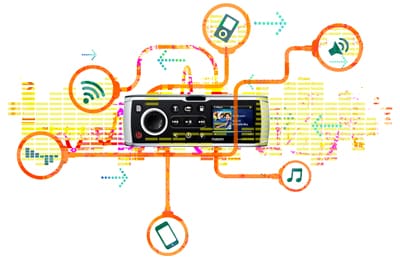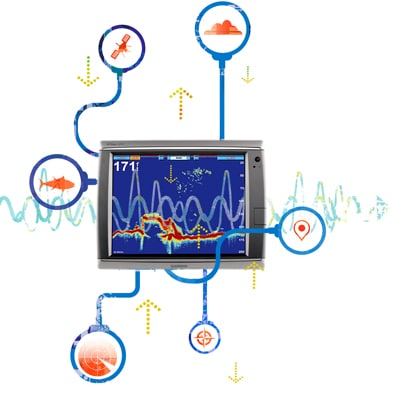If I have to pick the marine electronics trend of 2012, it’s got to be the integration of familiar dedicated boat devices with the wonders of mobile consumer electronics. Unless you boat to truly get away from it all (not that there’s anything wrong with that) you probably already know that phones and pads that can run apps and connect wirelessly to the Internet are even more valuable afloat than on land. I hardly need mention the hundreds of usually inexpensive charting, weather and other marine programs that are putting smiles on boaters everywhere. But the new trend that’s really sizzling, though it’s confusing, is what’s possible when those mobile app capabilities marry the modern multifunction display and other formerly unconnected marine devices.
Raymarine’s new e7 MFD is a good place to start (raymarine.com). It can connect in traditional wired ways with all sorts of Raymarine radars, black-box fish finders and so forth, plus a wide variety of sensors and even engines using standard NMEA protocols. But the 7-inch display also contains bidirectional Wi-Fi and Bluetooth wireless radios. Right out of the box, an e7 can stream its screen to a free iPad app called RayView, and it can also synchronize routes and tracks with the Apple and Android charting apps offered for download by Navionics (navionics.com) starting at $9.99.
But that’s just the beginning because Raymarine is committed to making the Wi-Fi iPad connection two-way, which will mean that a touch pad can serve as a second station to a touch-screen e7, and the mobile-to-MFD connection enables all sorts of other possibilities, like synchronizing chart and fishing/cruising information updates. The e7’s Bluetooth can be used to control tracks on many types of digital music players that might be plugged into a stereo mounted below, and it’s also used with Ray’s new RCU-3 wheel-mounted or lanyard-hung remote control, which you can use to manage tunes or basic chart-plotter commands.
Meanwhile, the CPN 7- and 10-inch multifunction displays announced by Standard Horizon (standardhorizon.com) last year also include Wi-Fi and Bluetooth and, when finally launched, will have some features like the e7, including a synchronized relationship to Jeppesen’s Plan2Nav iPad and iPhone apps (jeppesen.com), which are free with charts extra. The CPN’s bright, waterproof screen can also stream video media stored on a memory stick or streamed from a shore Wi-Fi access point, or even browse the Web or manage e-mail.
A good place to see what’s possible with the digital media so many of us carry in our pockets these days is the latest generation of Fusion marine stereos (fusionelectronics.com). The new MS-IP700 and MS-AV700 head units can not only distribute up to four zones of iTunes content, video included, and MP3 tunes around a boat, but they also offer three alternative forms of control. One is a full-featured NRX200 remote that installs easily using a boat’s existing NMEA 2000 network and can even show other data flowing on that cable, like boat speed or depth, on its 2.7-inch screen. The 700 Series head units also have an Ethernet port that can be used in two ways. When cabled to a boat’s Wi-Fi router, any apps phone or pad becomes a remote and is able to select tunes or manage the AM, FM or VHF receivers (Sirius optional). But Fusion is also offering a software license to MFD manufacturers so that we may also see full 700 Series controls on screens by Garmin, Raymarine, etc. Altogether then, there’s the integration of mobile media with marine electronics in many forms.

Actually, Aquatic AV’s new AQ-DM-4B Digital Media Locker illustrates yet another way that an iPod or MP3 player can find a safe and useful home on board (aquaticav.com). It’s simply a waterproof box with 4 x 72 watts of amplification and an FM tuner built in, and you control it with up to 10 two-way radio-frequency remotes that can even display iTunes song titles. There’s also a trigger switch so you can turn on, say, your cockpit lights from up to 50 feet away.
A totally different, even counterintuitive, way that smartphones are getting especially boat-friendly is as the interface to the satellite communications we might like when we cruise or fish beyond cellular range. The trend started with the SPOT Connect (findmespot.com), which does everything the familiar SPOT Messenger did — like tracking, sending canned “I’m OK” messages and making one-button distress calls — but also lets you use an Apple or Android app to send short custom texts or e-mails from anywhere there’s Globalstar coverage. This year such possibilities ramp up seriously with the introduction of the DeLorme inReach (delorme.com), which is built around an Iridium 9602 satellite modem that can do longer two-way messaging from virtually anywhere. The 9602 will soon be included in many devices, maybe even an MFD, and I’m hoping to see a boat-specific security and monitoring system like SPOT’s Hug with an app interface for flexible messaging.
I could go on and on with new ways mobile devices are being integrated with marine electronics, and I’m convinced that we’re seeing only the tip of the iceberg until the likes of Garmin and Navico show us what they’ve got cooking in their development labs. But there are some other trends in play, like the rapid development of certain purely marine technologies.
Consider compressed high-intensity radar pulse (CHIRP) fish finding, for instance. Last year I saw convincing demonstrations by both Simrad (simrad-yachting.com) and Garmin (garmin.com) showing how much better spread-spectrum sonar signals can image structure and fish than simple one-note pings can. This year Raymarine will join the CHIRP gang, and Airmar (airmar.com) continues to expand the variety of transducers that can support this vastly improved fish finding. And whereas the technology is built in large part on ever smaller, faster, smarter and less expensive signal processing, there’s reason to hope that it will get more accessible to smaller boats and budgets.

Radar is moving in a similar direction. Simrad and Lowrance (lowrance.com) continue to pioneer solid-state broadband radar, this year introducing a 4G model that purportedly both increases the extraordinary near-range resolution of the original models and decreases their long-range limitations. But the ongoing improvements in traditional magnetron radars — seen particularly in high-definition models from Furuno (furuno.com) and Raymarine — should not be overlooked. And this year Humminbird enters the small radar market with a 21-inch 4 kW radome that’s compatible with many of its existing MFDs and has a clever variable transmit exclusion zone that should make it as safe as broadband in tight-quarters installations.
Another great trend in marine electronics is LED backlit screens, which offer better performance and longer life while using less power. The technology is particularly noticeable in the rash of new all-in-one color instruments, like Raymarine’s i70, Furuno’s RD33, Geonav’s MID 110 (geonavmarine.com) and B&G’s Triton (www.bandg.com). And don’t think that these instruments are just for sailors these days. Most can display engine gauge data, rudder angle, waypoint highway and much more, sometimes even including automated information system (AIS) targets or sea temperature graphs. In all cases they can free an MFD to show more chart, radar or fish finder, and in some they can bridge a boat’s existing NMEA 0183 or SeaTalk data to NMEA 2000.
The trend I like the most, though, is that all the trends I’ve alluded to above are taking marine electronics to a place where really neat surprises are quite possible. And I’m not just talking about a fixed VHF radio with a GPS built in to make digital selective calling (DSC) distress calls simple, though Standard Horizon will have such an innovation this year. I’m thinking instead of the Fish Gate 100 (scalesbeyondmeasure.com), which is a precision scale with an NMEA 2000 connection so that catches can be logged with position, depth and water temperature. The product also includes software for computing tournament best-five-fish statistics, and a communications link so this data can get ashore in real time. A tablet app that integrates the data with photos and notes can’t be far behind. Besides tournaments, imagine sharing catch info between friends.
Or how about an underwater remotely operated vehicle (ROV) with an HD video camera that both displays on an iPad and is controlled by it? Check out the Aquabotix HydroView Sport ($2,995, aquabotix.com). Or consider Garmin’s GDL 40 cellular weather receiver. It does a nice job delivering XM-style weather overlays to Garmin MFDs for a reasonable daily fee. But it’s also a fast two-way connection between a boat’s NMEA 2000 network and shore. Imagine streaming live engine data to a mechanic instead of trying to explain that weird chukka-klunk sound you’re hearing. Another possibility is off-boat security. Garmin may be fixing to surprise us.
Mobile devices, industry standards and boat-specific technology improvements are coming together in unpredictable but exciting ways. My main advice about marine electronics these days is to prepare for change and expect better, more enjoyable technology.
As the senior marine electronics editor for the Bonnier Marine Group, Ben Ellison sometimes writes for Boating’s sister publications and also edits panbo.com, a blog about marine electronics.








